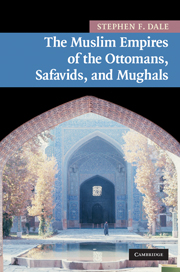Book contents
- Frontmatter
- Contents
- List of illustrations
- List of maps
- Preface
- Languages and transliteration
- Introduction
- 1 India, Iran, and Anatolia from the tenth to the sixteenth century
- 2 The rise of Muslim empires
- 3 The legitimacy of monarchs and the institutions of empires
- 4 The economies around 1600
- 5 Imperial cultures
- 6 Golden ages: profane and sacred empires
- 7 Imperial culture in the golden age
- 8 Quests for a phoenix
- Conclusion
- Glossary
- Dynastic lists
- Bibliography
- Index
3 - The legitimacy of monarchs and the institutions of empires
Published online by Cambridge University Press: 05 October 2014
- Frontmatter
- Contents
- List of illustrations
- List of maps
- Preface
- Languages and transliteration
- Introduction
- 1 India, Iran, and Anatolia from the tenth to the sixteenth century
- 2 The rise of Muslim empires
- 3 The legitimacy of monarchs and the institutions of empires
- 4 The economies around 1600
- 5 Imperial cultures
- 6 Golden ages: profane and sacred empires
- 7 Imperial culture in the golden age
- 8 Quests for a phoenix
- Conclusion
- Glossary
- Dynastic lists
- Bibliography
- Index
Summary
Introduction
Following the emergence of the Ottoman, Safavid, and Mughal dynasties, there was a subsequent ruler in each ruling lineage who transformed the nature of his state. In the fifteenth and sixteenth centuries these were the Ottoman Fatih Mehmet, that is Mehmet II, the Conqueror (1444–81); the Safavid Shah ‘Abbas I (1588–1629); and the Mughal Akbar (1556–1605). Each of them exhibited an adaptive personality and personal dynamism that enabled him to mold the state he inherited into a distinctly different and more formidable imperial entity. They did not play precisely analogous roles, since their dynasties had distinct histories and characteristics. In 1444 Mehmet II inherited a powerful and expansionist Anatolian and Balkan sultanate with established military, political, and religious institutions. Yet by his conquest of Constantinople and subsequent policies he substantially altered the Ottomans’ self-perceptions as well as the character of the Ottoman state. By the time of his death the Ottoman Sultanate had become a dominant, highly centralized slave empire whose ruler possessed hitherto unequalled autocratic power. In contrast, Shah ‘Abbas at age sixteen in 1588 inherited a fragile Safavid regime with a questionable future. During the sixteenth century Isma‘il's original religious charisma had atrophied in the face of his defeat at Chaldiran in 1514 and subsequent inertia, and his successors had proved incapable either of solving the intractable internecine conflicts and independent power of the Qizilbash or of decisively defeating their Ottoman and Uzbek enemies.
- Type
- Chapter
- Information
- The Muslim Empires of the Ottomans, Safavids, and Mughals , pp. 77 - 105Publisher: Cambridge University PressPrint publication year: 2009



